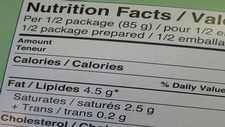Evaluate Promotional Materials

TEKS Objective
The student is expected to draw inferences and evaluate accuracy of product claims found in advertisements and labels such as for toys and food.
Essential Understanding
The student knows that information, critical thinking, scientific problem solving, and the contributions of scientists are used in making decisions.
Science Background
Reading Nutrition Labels: American Heart Association (website): Information on how to read and evaluate the components of nutrition label.
Reading Nutrition Labels
American Heart Association, www.heart.org
Bouncing Balls: Exploratorium (website) – Information about why balls bounce and how to test this property.
Signature Lesson
Using Food Labels: BioEd Online (website) - To promote healthful food choices, students learn about, and evaluate the accuracy of food nutritional labels. The activity also includes information about serving sizes and an investigation of the amount of sugar present in common soft drinks.
- Supporting Lessons
- Extensions
- Assessment Ideas
- Literature Connections
- Related
TEKS - Additional Resources
Supporting Lessons
Predicting the Behavior of a Bouncing Ball: Science Online (website) – Balls of different types of materials are compared by how high they can bounce. Students discuss how each ball has certain properties specific to the sport it is made for.
Predicting the Behavior of a Bouncing Ball
Science Online, scienceonline.tki.org.nz
Elaboration Lessons and Extensions
How Much Fat is Hidden in Your Favorite Foods? BioEd Online (PDF) - See page 6 of this informational student booklet for a simple hands-on activity in which students investigate the relative amounts of fat in different products. Compare similar products, such as white and wheat bread, sugar free and regular cookies, etc. Relate results to the information on the food labels. The booklet contains other fun, useful information and activities related to food labels and nutrition.
How Much Fat is Hidden in Your Favorite Foods?
BioEd Online, www.bioedonline.org
Assessment Ideas
Healthy Snacks: BioEd Online (website) - Students use information on food labels to rank sample foods, from most to least healthful. Students then write short essays to explain their rankings. Student pages presented in English and Spanish.
Literature Connections
Looking at Labels. Burstein, John (ISBN-13: 978-0778739357)
Food Labels. McCarthy, Rose (ISBN-13: 978-1404216334)
The Mysterious Marching Vegetables. Tharp, B., Dresden, J., Denk, J., Moreno, N. (ISBN-13: 978-1888997378)
The Mysterious Marching Vegetables.
BioEd Online, www.bioedonline.org
Additional Resources
Advertising Claims: Federal Trade Commission (website) - Scroll down to the “Nutrition Emporium” link for an interactive activity in which students investigate advertising claims. In the process, they learn that ads are not always accurate.
TEKS Navigation
Grade 3
Need Assistance?
If you need help or have a question please use the links below to help resolve your problem.

Comments